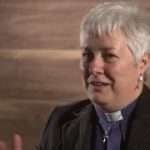Search the index of Ireland Since the Famine, F.S.L. Lyons’ seminal work on Irish history, for Sheehy-Skeffington, and the name is easily found – the name of Francis Sheehy-Skeffington is easily found. Search the text and the references are all to Sheehy-Skeffington and his murder. Sheehy-Skeffington is described by Lyons as,
‘one of the best-loved figures in Dublin and a notable champion of all sorts of minority causes. He was a teetotaller, a vegetarian, a worker for women’s rights, a socialist, above all a pacifist’.
No mention whatsoever of Hanna, his wife, from whom Francis Skeffington had acquired the surname ‘Sheehy’; no mention of Hanna’s role as a founding figure of the Irish women’s movement; no mention of Hanna being imprisoned for her beliefs; no mention of the sense of betrayal felt by radical women at the conservative Catholic clerical state that emerged after 1922. Lyons, writing in 1971, had remained uninfluenced by the women’s movement that emerged in the 1960s to write a history completely excluding Hanna Sheehy-Skeffington.
Lyons seems not to have been favourably disposed to the idea that women might play a significant role in history. Neither the women’s movement nor the suffrage movement find a place in the index of Ireland Since the Famine, though the Ladies’ Land League is mentioned; it is a subject for opprobrium. Writing of agrarian violence during the time of the imprisonment of Charles Stewart Parnell between mid-October 1881 and 1882, Lyons comments:
‘Much of this, as the Chief Secretary himself pointed out, was due to the growth or revival of secret societies, though it may also to some extent have been the product of the irresponsible behaviour of the Ladies Land League, organised by Anna Parnell to keep up the running while her brother was in prison, but regarded by him as so reprehensible that one of the first things he did on his release was to suppress it’.
Lyons’ choice of words leaves no doubt as to his own personal assessment of the role women played in the movement.
There has been a long tradition of overlooking women in the writing of history.
Forty-five years after Lyons wrote his history, at a level altogether insignificant compared with those who shaped the history of the nation, the omission of women continued in ecclesiastical writing. Published in 2006, ‘The Clergy of the Church of Ireland, 1000-2000: Messengers, watchmen and stewards’ makes no reference to the first woman ordained in the church; as if the place of women in the church was incidental to the real business being done by men.
This evening marked the 25th anniversary of the first ordination of a woman by the Church of Ireland; the 25th anniversary of the first admission of a woman in Ireland to the ancient threefold order of deacon, priest and bishop. Perhaps what matters is that historians write history; rarely are they the people who make it.
